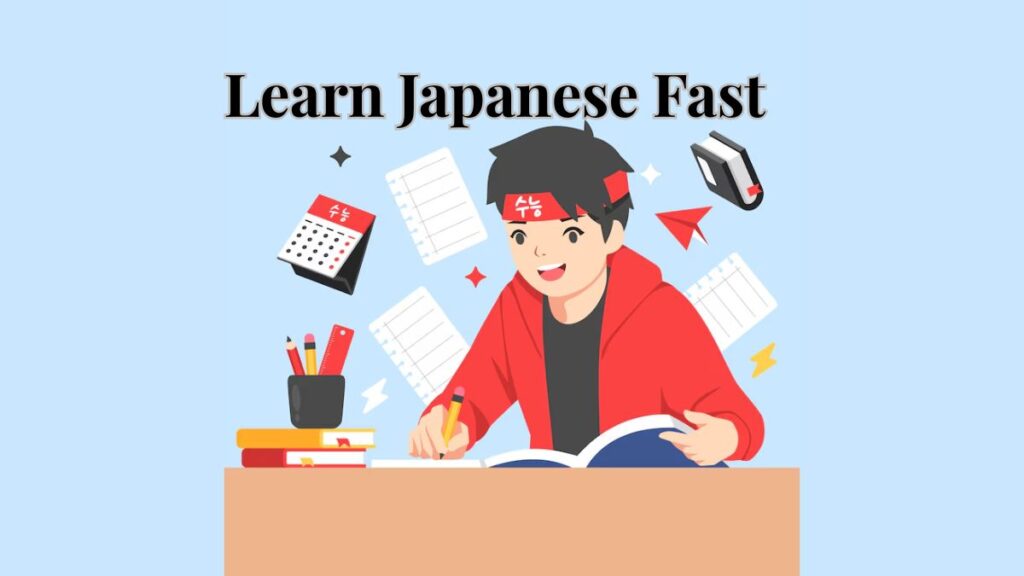In today’s global world, mastering a second language can open doors to exciting opportunities, and Japanese is among the most sought-after. With its rich culture, economic significance, and increasing global influence, more people are searching for ways to learn Japanese fast. While Japanese may seem difficult at first, with the right strategy, tools, and mindset, you can make significant progress quickly.
This comprehensive guide explores effective methods to accelerate your Japanese learning journey. Whether you’re preparing for travel, studying for JLPT exams, planning to work in Japan, or simply exploring a passion for language, this article will show you how to learn Japanese fast and efficiently.
Why Learn Japanese?
Global Influence of the Japanese Language
Japanese is spoken by over 125 million people, primarily in Japan, the third-largest economy in the world. Japan’s contribution to technology, gaming, anime, and global business makes Japanese a highly practical and respected language.
Career and Academic Opportunities
Knowing Japanese can open career opportunities in international business, translation, teaching, tourism, and more. Universities also favor students with multilingual capabilities.
Cultural Appreciation
From anime and manga to tea ceremonies and sumo wrestling, learning the language gives you direct access to Japanese culture, traditions, and media in their most authentic forms.
Understanding the Challenges
Complex Writing Systems
Japanese uses three scripts: Hiragana, Katakana, and Kanji. Learning them can be intimidating but is essential for fluency.
Grammar Differences
Japanese grammar is structure-heavy and quite different from English. For instance, verbs often appear at the end of sentences, and subject omission is common.
Pronunciation and Politeness Levels
Pronunciation is relatively straightforward, but the language includes multiple levels of politeness (formal, informal, humble, honorific) which require practice and cultural understanding.
Setting Realistic Goals for Fast Learning
Define Your Purpose
Knowing why you want to learn Japanese fast helps tailor your approach. Goals could include:
- Conversational fluency for travel
- Passing JLPT exams
- Understanding anime or literature
- Business communication
Create SMART Goals
Use the SMART framework (Specific, Measurable, Achievable, Relevant, Time-bound):
- Specific: Learn 100 kanji in 30 days
- Measurable: Study 2 hours daily
- Achievable: Focus on N5 vocabulary and grammar
- Relevant: Practice speaking for an upcoming trip
- Time-bound: Reach conversational fluency in 3 months
Core Elements to Learn Japanese Fast
Master Hiragana and Katakana Quickly
Start with Hiragana and Katakana since they’re the foundation of reading and writing. Use flashcards, apps, and mnemonic devices to speed up recognition and writing.
Learn Basic Grammar First
Grasp basic sentence structures (Subject-Object-Verb), particles like は (wa), を (wo), and で (de), and common verb forms such as ~ます and ~ました.
Use the Power of Kanji Efficiently
Instead of memorizing all 2,000+ kanji, start with the most common 100–300 used in daily life. Use radicals and stories to make kanji easier to remember.
Best Tools to Learn Japanese Fast
Mobile Apps
- Anki – For spaced repetition flashcards
- Duolingo – For gamified beginner lessons
- Tae Kim’s Guide – For grammar reference
- WaniKani – For mastering Kanji
Online Courses
Choose structured online courses that match your goals—some focus on business language, others on daily conversation or academic study.
Textbooks and Workbooks
Books like Genki, Minna no Nihongo, and Japanese for Busy People offer comprehensive beginner to intermediate learning material.
Speaking from Day One
Practice Pronunciation
Start with basic sounds and gradually build up. Japanese pronunciation is relatively phonetic, which makes early speech practice easier.
Language Exchange Partners
Use platforms to connect with native speakers. Real conversations help solidify vocabulary and grammar in a practical way.
Use Shadowing Technique
Listen to a Japanese sentence, then repeat it immediately. It builds listening and speaking fluency fast.
Immersion Techniques
Change Your Environment
Switch your devices to Japanese, label items in your house, or listen to Japanese music, podcasts, and YouTube channels.
Watch Anime and Japanese Dramas
Watch with subtitles first, then rewatch with Japanese audio only. Take note of common expressions and mimic the intonation.
Read Children’s Books and Manga
Start with simple stories. Books like Yotsuba&! or Shirokuma Cafe offer accessible vocabulary and grammar for beginners.
Expand your knowledge and check out more posts on our blog!
Time Management for Fast Learning
Create a Daily Routine
Consistency is key. Even 30–60 minutes daily is better than cramming once a week.
Example routine:
- 10 min: Review flashcards
- 15 min: Grammar study
- 15 min: Listening practice
- 20 min: Speaking or writing practice
Use Spaced Repetition
Tools like Anki use SRS (Spaced Repetition System) to help you remember vocabulary over longer periods by reviewing at optimal intervals.
Accelerate Progress with These Tips
Focus on High-Frequency Words
Learn the most common 1,000–2,000 words used in daily conversation first. They make up over 80% of spoken language.
Speak Without Fear of Mistakes
Don’t aim for perfection. Use the language daily, even if it’s broken. Fluency comes from practice, not perfection.
Learn in Context
Instead of memorizing isolated vocabulary, learn words through phrases and sentences.
Join Japanese Language Communities
Engage with other learners online. Communities provide support, tips, and accountability to stay motivated.
Learning Japanese for Specific Goals
For Travel
Focus on survival phrases:
- どこですか?(Where is it?)
- いくらですか?(How much is it?)
- お願いします (Please)
- 助けて!(Help!)
For Work
Study business vocabulary, honorific language (keigo), and writing formal emails in Japanese.
For JLPT
Use past JLPT papers and study guides. Focus on vocabulary, kanji, grammar, reading, and listening related to your JLPT level.
Common Mistakes to Avoid
1. Skipping Kana and Jumping to Kanji
Learning kana is foundational—don’t rush into kanji without mastering these.
2. Only Using Romaji
Romaji (Romanized Japanese) is useful at the start, but relying on it will stunt your reading and writing progress.
3. Passive Learning
Simply reading or watching won’t help you speak. Practice output (speaking and writing) daily.
4. Overusing Translation
Try to think in Japanese and associate Japanese words with concepts, not their English equivalents.
Staying Motivated While Learning Japanese Fast
Set Milestones and Celebrate Small Wins
Pass a quiz? Have a 5-minute conversation? Celebrate! Small victories keep motivation high.
Track Progress
Use journals, apps, or visual trackers to monitor your growth. Seeing improvement over time boosts confidence.
Stay Curious
Dive into Japanese culture. The more you’re emotionally invested, the faster you’ll learn.
Conclusion
Learning Japanese fast is completely achievable with commitment, smart strategies, and consistent practice. Whether you’re preparing for travel, exams, or exploring a passion, the key is to combine efficient tools, engaging content, and real-world practice.
Don’t be discouraged by the complexity of kanji or grammar. Start with the basics, build daily habits, and immerse yourself in the language. With discipline and the right techniques, your journey to fluency will be not only fast but also deeply rewarding.
Unique FAQs About Learn Japanese Fast
1. What is the fastest way to learn Japanese?
The fastest way involves mastering kana first, using spaced repetition tools for vocabulary, and speaking daily with native speakers or tutors.
2. How long does it take to learn Japanese fluently?
With intensive study (2–3 hours/day), basic fluency can be achieved in 6–12 months. Full fluency may take 2–3 years, depending on goals.
3. Can I learn Japanese on my own without a teacher?
Yes, with access to online courses, language apps, and immersion practices, self-learners can make significant progress without a classroom.
4. Is Japanese harder to learn than other languages?
Japanese has a steeper initial learning curve due to kanji and grammar, but its consistent pronunciation and sentence patterns help over time.
5. Should I learn Hiragana or Katakana first?
Start with Hiragana, as it’s used more commonly in native Japanese words. Katakana is primarily used for foreign words and names.







